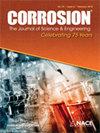Investigation of iron dissolution mechanism in acidic solutions with and without dissolved CO2 – Part I: EIS measurements
IF 1.1
4区 材料科学
Q4 MATERIALS SCIENCE, MULTIDISCIPLINARY
引用次数: 0
Abstract
Aqueous CO2 corrosion of mild steel is one of the major problems in the oil and gas industry. While current understanding primarily focuses on cathodic reaction mechanisms, less attention has been given to the impact of aqueous CO2 on the anodic iron dissolution reaction. In contrast, the mechanism of iron dissolution in strong acidic environments has been thoroughly investigated. Among the reaction mechanisms found in the open literature, a multi-path mechanism was identified that could explain the iron dissolution in strong acidic sulfate solution; both in terms of steady state polarization sweeps and impedance data at various pH values and current densities. However, the role of aqueous CO2 in solutions containing chlorides on the mechanism of iron dissolution had remained an open question. The present study used electrochemical impedance spectroscopy (EIS) as the main technique, to study the mechanism of iron dissolution in strong acid chloride solution with and without the presence of CO2. Results showed that the presence of chloride ions (0.5 M) decreases the rate of iron dissolution by competing with hydroxide ions to adsorb on the metal surface, forming chloride-containing intermediate species that participate in the iron dissolution reaction. The resulting decrease in the availability of hydroxide intermediates, which are more effective at enhancing the reaction rate compared to chloride-containing intermediates, leads to an overall decrease in the rate of iron dissolution. While the presence of CO2 increases anodic current density, EIS investigation revealed that neither aqueous CO2 nor other carbonic species directly react on the bare metal surface to form adsorbed intermediates involved in the anodic reaction. EIS investigation suggested that aqueous CO2 may induce changes in the chemical composition of adsorbed species, rate constants, and surface coverage, thereby altering the kinetics of the underlying reactions.有二氧化碳溶解和无二氧化碳溶解的酸性溶液中铁溶解机理的研究 - 第 I 部分:EIS 测量
二氧化碳水溶液对低碳钢的腐蚀是石油和天然气行业的主要问题之一。目前的认识主要集中在阴极反应机制上,而较少关注二氧化碳水溶液对阳极铁溶解反应的影响。相反,在强酸性环境中铁溶解的机理已经得到了深入研究。在公开文献中发现的反应机理中,有一种多路径机理可以解释强酸性硫酸盐溶液中的铁溶解;无论是从稳态极化扫描还是从不同 pH 值和电流密度下的阻抗数据来看,都是如此。然而,含氯化物溶液中的二氧化碳水溶液对铁溶解机理的作用仍是一个未决问题。本研究以电化学阻抗谱(EIS)为主要技术,研究了二氧化碳存在和不存在的强酸氯化物溶液中铁的溶解机理。结果表明,氯离子(0.5 M)的存在会降低铁的溶解速率,因为氯离子会与氢氧根离子竞争吸附在金属表面,形成含氯化物的中间物质,参与铁的溶解反应。与含氯中间体相比,氢氧化中间体能更有效地提高反应速率,氢氧化中间体的减少导致铁溶解速率总体下降。虽然二氧化碳的存在会增加阳极电流密度,但 EIS 调查显示,水溶液中的二氧化碳或其他碳化物都不会直接在裸金属表面发生反应,形成参与阳极反应的吸附中间产物。EIS 研究表明,二氧化碳水溶液可能会导致吸附物种的化学成分、速率常数和表面覆盖率发生变化,从而改变基本反应的动力学。
本文章由计算机程序翻译,如有差异,请以英文原文为准。
求助全文
约1分钟内获得全文
求助全文
来源期刊

Corrosion
MATERIALS SCIENCE, MULTIDISCIPLINARY-METALLURGY & METALLURGICAL ENGINEERING
CiteScore
2.80
自引率
12.50%
发文量
97
审稿时长
3 months
期刊介绍:
CORROSION is the premier research journal featuring peer-reviewed technical articles from the world’s top researchers and provides a permanent record of progress in the science and technology of corrosion prevention and control. The scope of the journal includes the latest developments in areas of corrosion metallurgy, mechanisms, predictors, cracking (sulfide stress, stress corrosion, hydrogen-induced), passivation, and CO2 corrosion.
70+ years and over 7,100 peer-reviewed articles with advances in corrosion science and engineering have been published in CORROSION. The journal publishes seven article types – original articles, invited critical reviews, technical notes, corrosion communications fast-tracked for rapid publication, special research topic issues, research letters of yearly annual conference student poster sessions, and scientific investigations of field corrosion processes. CORROSION, the Journal of Science and Engineering, serves as an important communication platform for academics, researchers, technical libraries, and universities.
Articles considered for CORROSION should have significant permanent value and should accomplish at least one of the following objectives:
• Contribute awareness of corrosion phenomena,
• Advance understanding of fundamental process, and/or
• Further the knowledge of techniques and practices used to reduce corrosion.
 求助内容:
求助内容: 应助结果提醒方式:
应助结果提醒方式:


